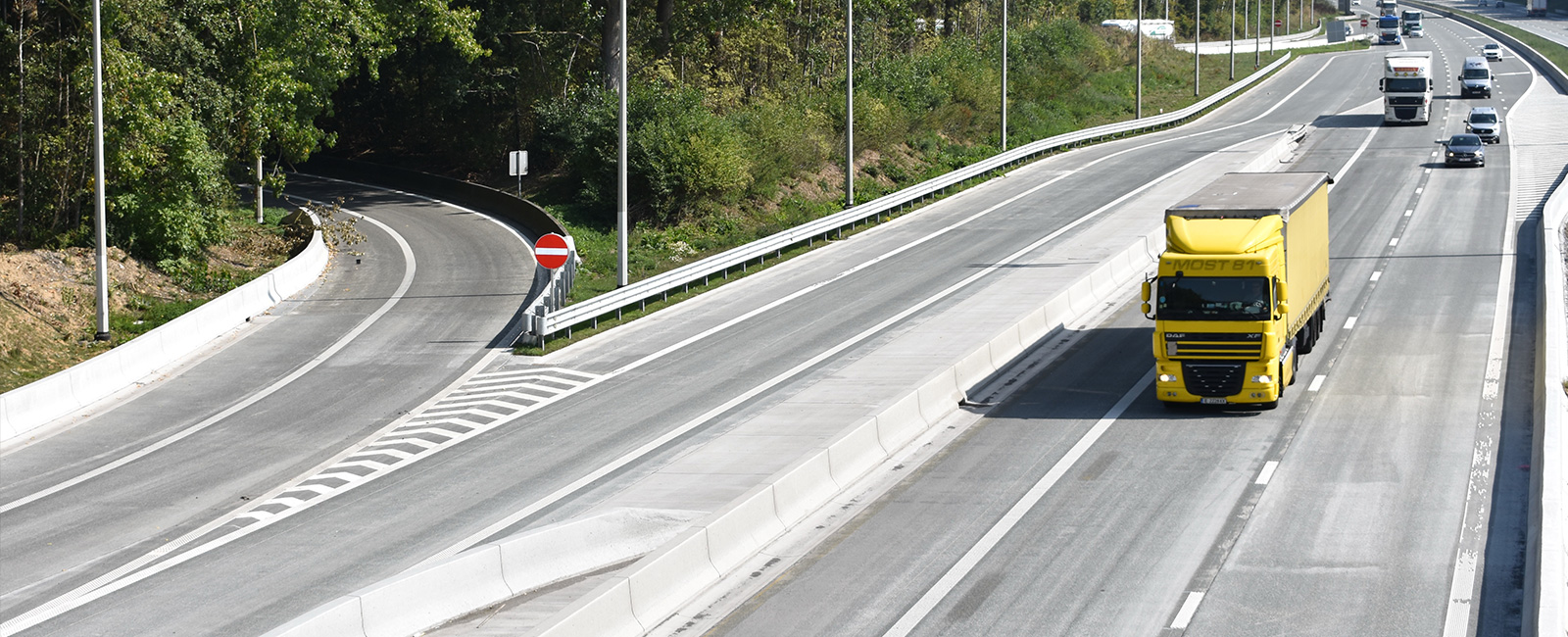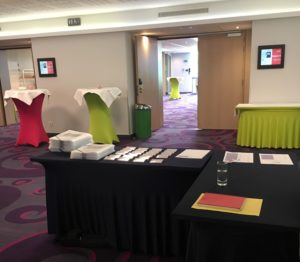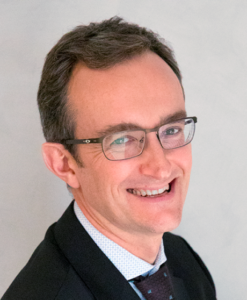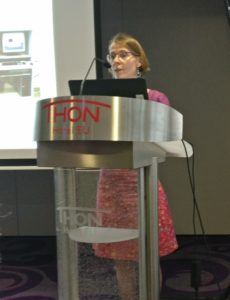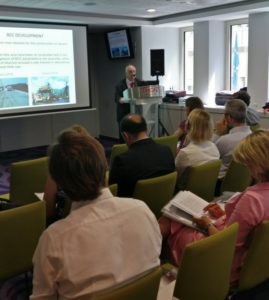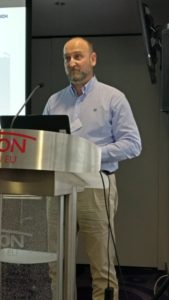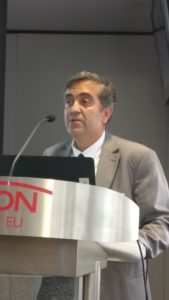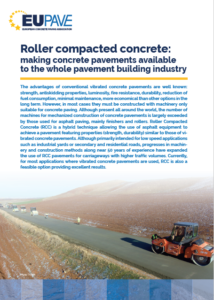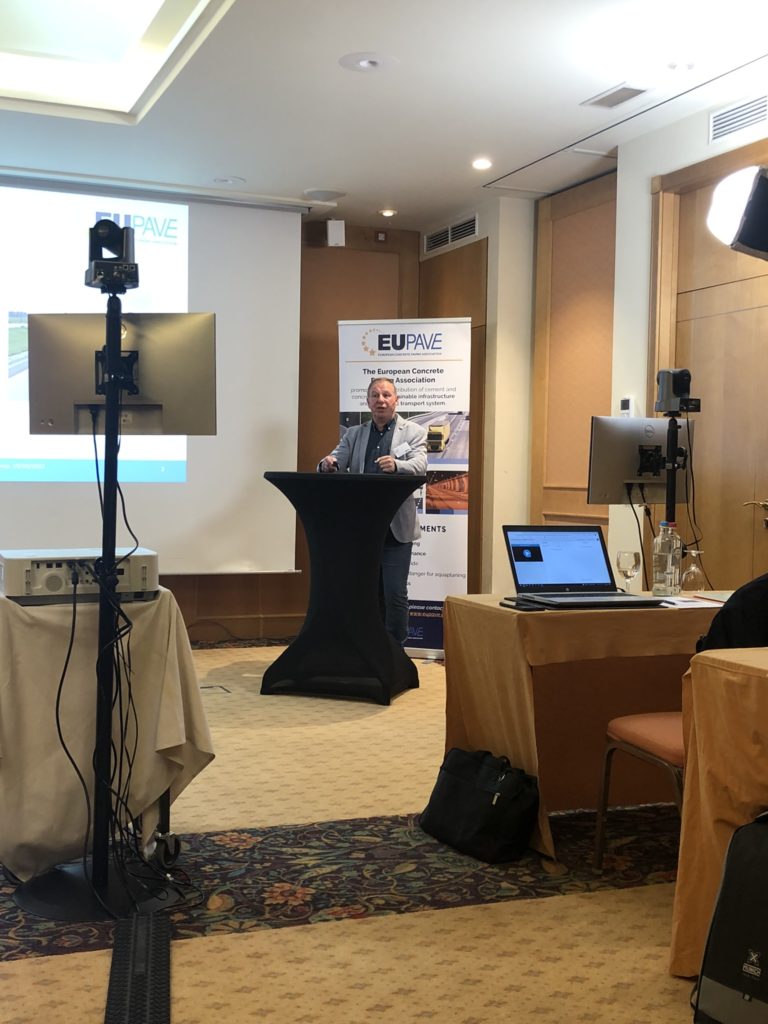
On Wednesday 19th October 2022, EUPAVE held at Hôtel Le Châtelain in Brussels its 7th workshop on Best Practices in Concrete Paving. The theme for this year was “Concrete Overlays”.
It was organised as a hybrid event, using a professional sound and video-system from the Dutch “Betonhuis” (“Concrete House”).
A concrete overlay is a concrete paving layer that is placed over an existing pavement. When properly designed and constructed, concrete overlays provide cost-effective, long-life, sustainable pavement rehabilitation options for a broad range of pavement types, existing pavement conditions, and project needs. This workshop gave an overview of the basic principles of concrete overlay design and construction and European and American practical experiences.
Mr. Luc Rens, Managing-Director of EUPAVE, opened the workshop and welcomed the participants.
He introduced EUPAVE, its mission and gave an overview of the previous workshops on Best Practices. He briefly introduced the EUPAVE’s latest publication “Guide for Design of Concrete Overlays” drafted by Mark Snyder.
Then, Mr. Snyder, Ph.D., P.E., Pavement Engineering and Research Consultant, LLC, presented the Guide to the participants. The publication includes a description of the different type of concrete overlays, an explanation of concrete overlay design and construction, amongst other topics.
You can find the Guide here.
The second presentation was on “Spanish experiences: a concrete overlay for a quarry road and a roundabout” by Sergio Carrascón, former Director North Est, IECA. Sergio showed different projects realised in Spain including the work done at La Jonquera (Girona, Spain) and the structural rehabilitation of pavement in 4 roundabouts and the rehabilitation of pavement done at Morata de Jalón (Zaragoza, Spain).
Jeroen de Vrieze, Advisor Promotion and Market Statistics at Betonhuis gave a presentation on the “Dutch experiences: overlays of cycle paths with fibre reinforced concrete by contractor Schagen Infra”.
After the coffee break, Lukas Eberhardsteiner, Assistant Professor at TU Wien, presented the “Austrian design method and catalogue for bonded concrete overlays”.
Ozgur Yaman, Professor at the Middle East Technical University of Ankara gave a well-illustrated presentation of “Overlay applications in the bus rapid transit lanes of Istanbul”. Mr. Yaman explained the biggest challenge they encountered was related to the construction issues.
Finally, Luc Rens, Managing Director of EUPAVE, concluded with the “Belgian experiences – thin and conventional inlays and overlays”.
The presentations were followed by a Q&A from both the live audience and the on-line participants. For the in-person participants, the afternoon ended with a pleasant networking cocktail.
The recording and presentations of the workshop are available for registered participants.
We would like to thank:
- All speakers for their efforts in preparing the presentations and the willingness to share their knowledge and experience
- All participants, live or online, for showing your interest in EUPAVE and the concrete pavement technology
- All our Members & Partners for the support to our association
- And a special thanks to our colleague Jeroen de Vrieze and the Dutch Betonhuis for the use of the audio-visual system.
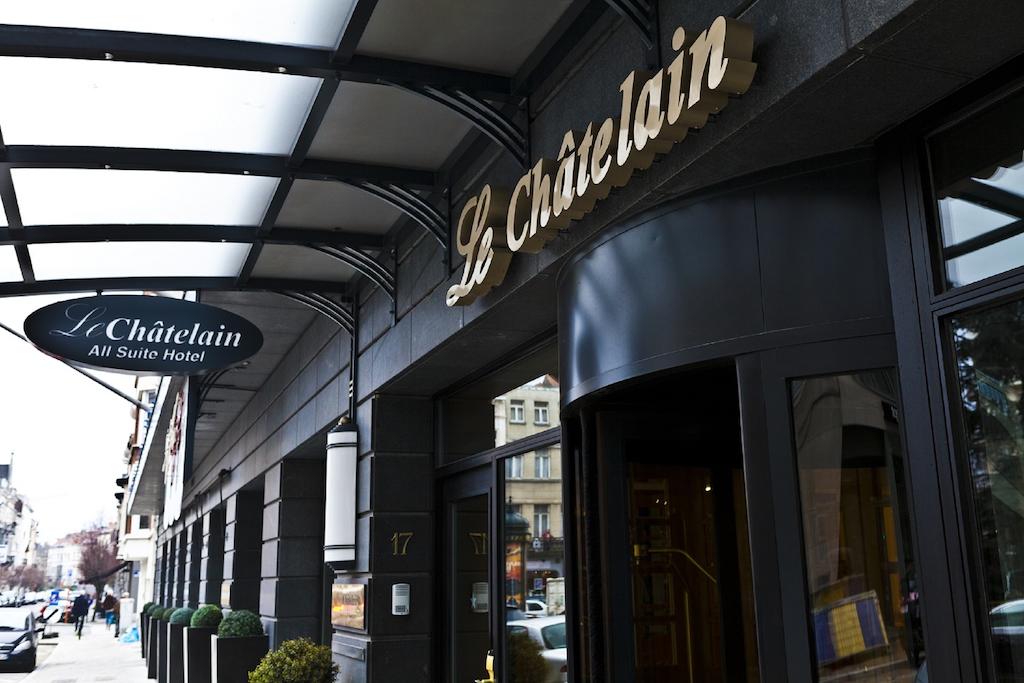
© Hôtel Le Châtelain
On Wednesday 14th October, EUPAVE held at Hôtel Le Châtelain in Brussels its 5th workshop on Best Practices in Concrete Paving. The theme for this year was “Concrete Pavement Preservation”.
Initially planned in March 2020, the workshop had to be rescheduled due to the sanitary crisis.
EUPAVE then decided to combine both a physical (limited to 10 persons) and an online event by broadcasting the event live. Attended by around 50 participants, the workshop/webinar gathered six experts in concrete paving.
Mr. Luc Rens, Managing-Director of EUPAVE, opened the workshop and welcomed the participants on behalf of Mr. Jeroen de Vrieze, chairman of EUPAVE Best Practices working group. Mr. de Vrieze could not physically attend due to the restrictive travel measures.
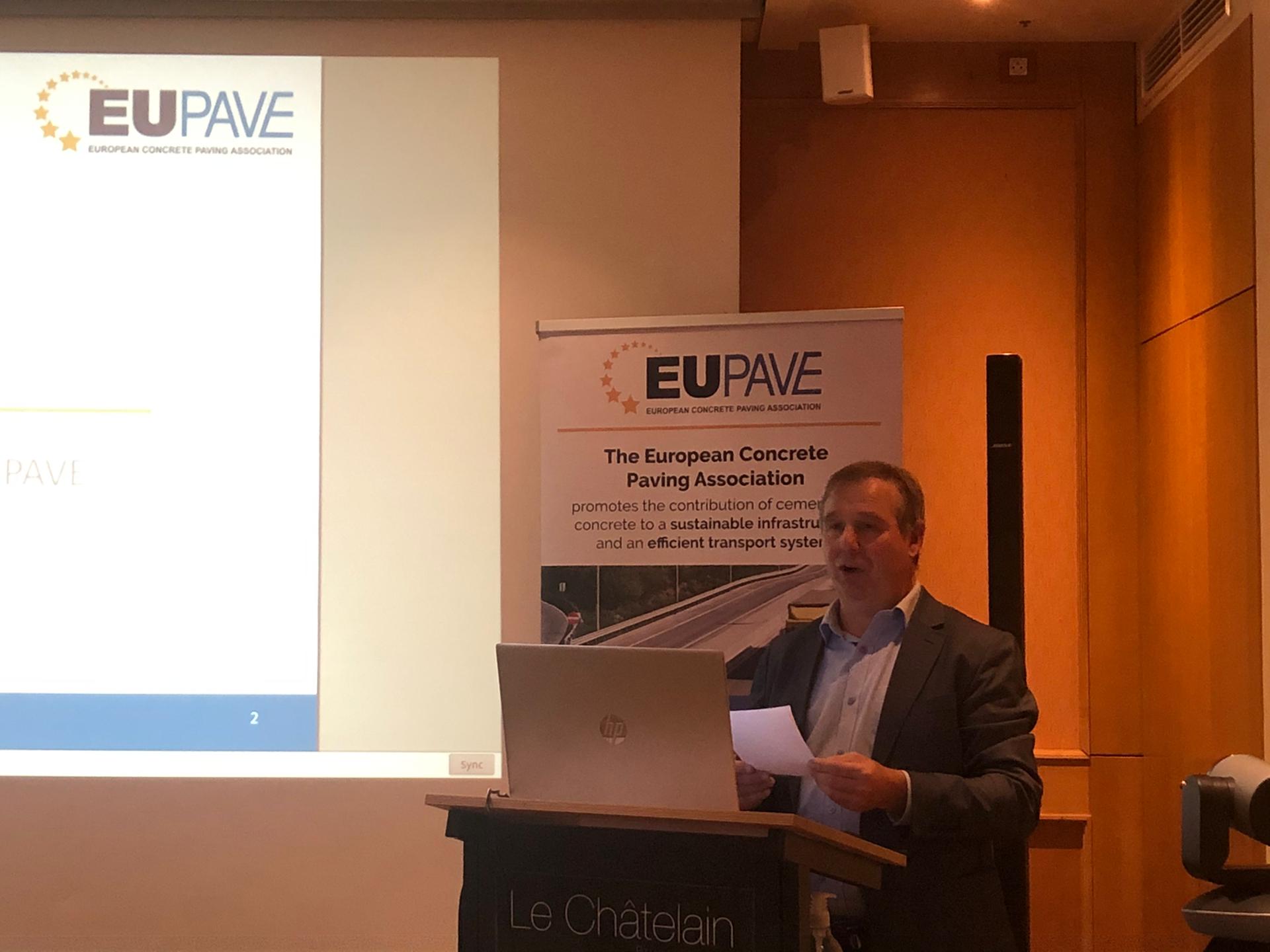
Luc Rens
Mr. Rens started the event with a presentation on the definition, concepts and strategies of concrete pavement preservation. Referring to an excellent publication on Concrete Pavement Preservation by the U.S. Federal Highway Administration, he presented a broader definition of CPP as “a strategy of extending concrete pavement service life as long as possible by arresting, greatly diminishing or avoiding the pavement deterioration process”. This strategy can be achieved by
- Designing and constructing durable long-life concrete pavements (LLCP structurally adequate and relatively distress-free throughout a long service life)
- Overlays (asphalt or concrete) as a preservation treatment
- Maintaining serviceability of the existing concrete pavement using CPR (restoration) treatments
He briefly spoke about some surface restoration techniques as a possible CPR treatment: diamond grinding, the Next Generation Concrete Surface, fine-milling and micro-milling.
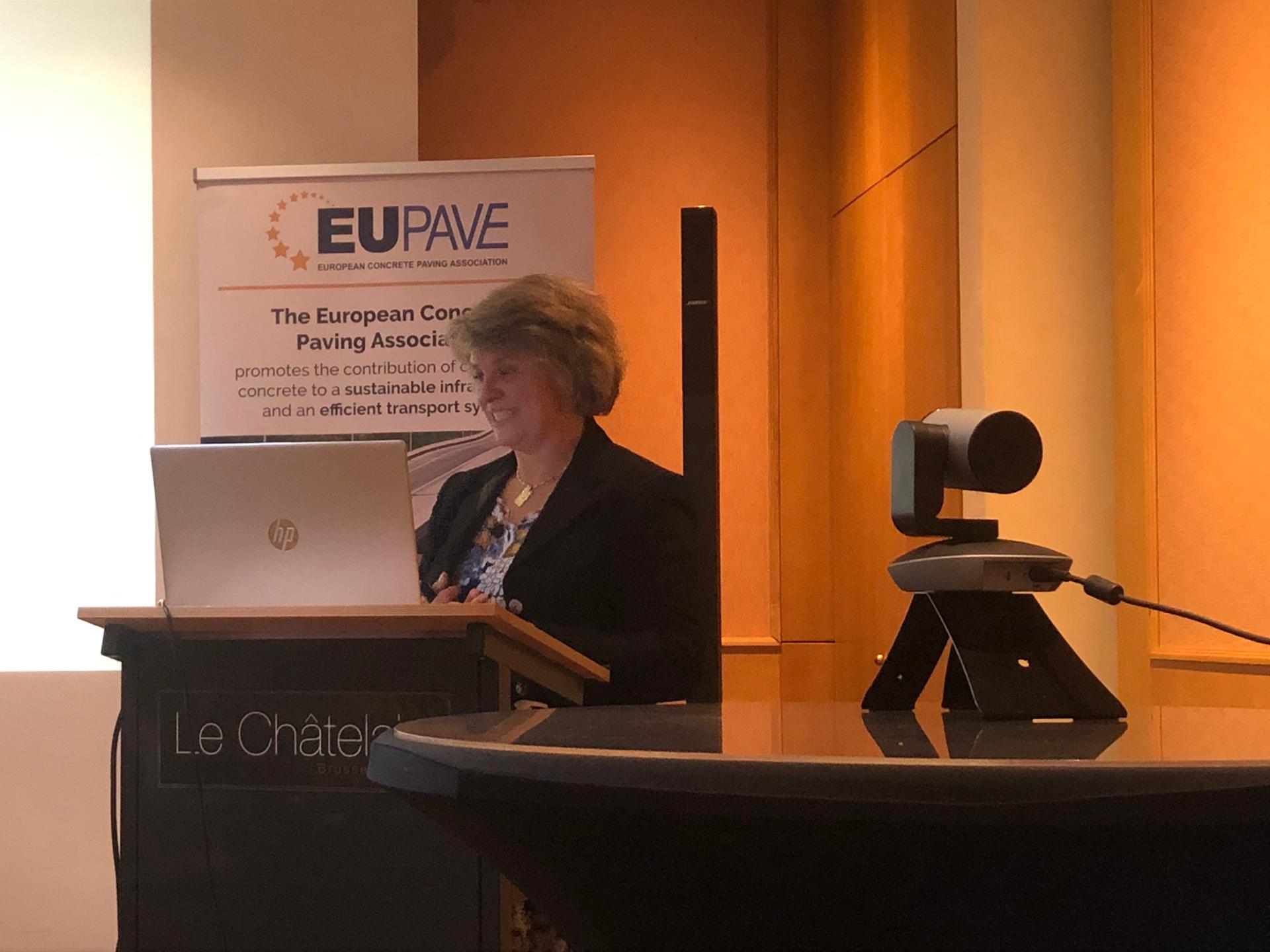
Anne Beeldens
Mrs. Anne Beeldens, owner and Consulting Engineer at AB-Roads gave a presentation on “Road Auscultation and Condition Assessment”. The well-illustrated presentation, including several practical cases, dealt with the following three domains:
- Evaluating structural adequacy: ability to withstand repeated structural loading
- Assessing the durability of the pavement materials: ability to withstand environmental deterioration
- Assessing the functional adequacy of the pavement
- Smoothness
- Noise
- Skid resistance…
Followed two presentations on “Maintenance and Repair Techniques for Concrete Slabs” from Mr. Pascal Buys and Mr. Tim Alte-Teigeler. As Mr. Alte-Teigeler could not attend the event in person, his presentation was pre-recorded.
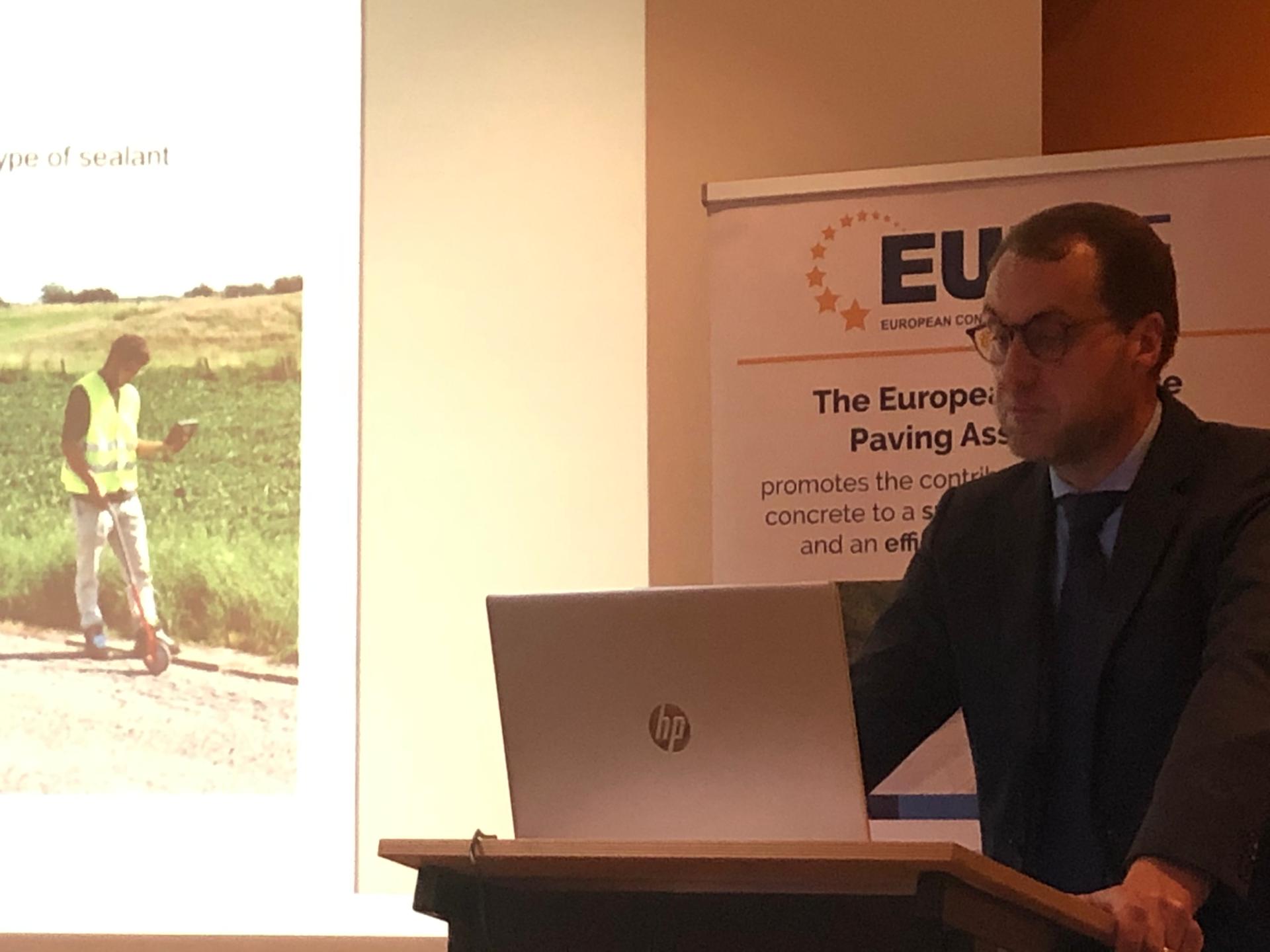
Pascal Buys
Mr. Buys, Managing-Director of Robuco, talked about the different options for joint maintenance and crack repair and presented the benefits of dowel bar retrofit, with a case study of the N44 in Belgium. Restoring the load transfer between slabs can easily extend the service life of an old concrete road (> 50 years in this case) by more than 10 years.
Mr. Tim Alte-Teigeler, Head of R&D of Otto Alte-Teigeler GmbH, focused on cross stitching, partial depth repair, lifting and stabilizing of slabs and full depth repair. He stressed the importance to choose the suitable repair technique for any pattern of damage. In order to ensure the long service life of concrete pavements, repair measures have to be applied on short notice after damages occur.
After a coffee break, Mr. Didier Snoek, Researcher at Magnel-Vandepitte Laboratory for Structural Engineering and Building Materials at Ghent University introduced the “Self-healing concrete by means of superabsorbent polymers”. His presentation included information on hydrogels, microstructure, self-sealing and seal-healing. This innovative development is obviously a promising solution for concrete pavement preservation in the future. Field tests are already going on in some projects, confirming the laboratory results.
Finally, Mr. Elia Boonen, Researcher at the Belgian Road Research Centre, talked about “Durable repair and rehabilitation of CRCP”. The principles for continuously reinforced concrete are different compared to jointed plain concrete. In the first place, the continuity of the longitudinal steel always needs to be restored in case of repairs. Different repair techniques were presented as well as some larger rehabilitation projects.
Presentations were followed by a Q&A.
Luc Rens ended the workshop with some words of conclusion.
Presentations:
1. Luc Rens – Intro & CPP – EUPAVE BP Workshop, 14102020
2. Anne Beeldens – Road auscultation and condition assessment – EUPAVE BP Workshop, 14102020
3. Pascal Buys – Maintenance repair tech concrete slabs – EUPAVE BP Workshop, 14102020
4. Tim Alte-Teigeler – Maintenance and repair techniques for concrete slabs – EUPAVE BP Workshop, 14102020
5. Didier Snoeck – Self-healing concrete – EUPAVE BP Workshop, 14102020
6. Elia Boonen – CRCP Repair – EUPAVE BP Workshop, 14102020
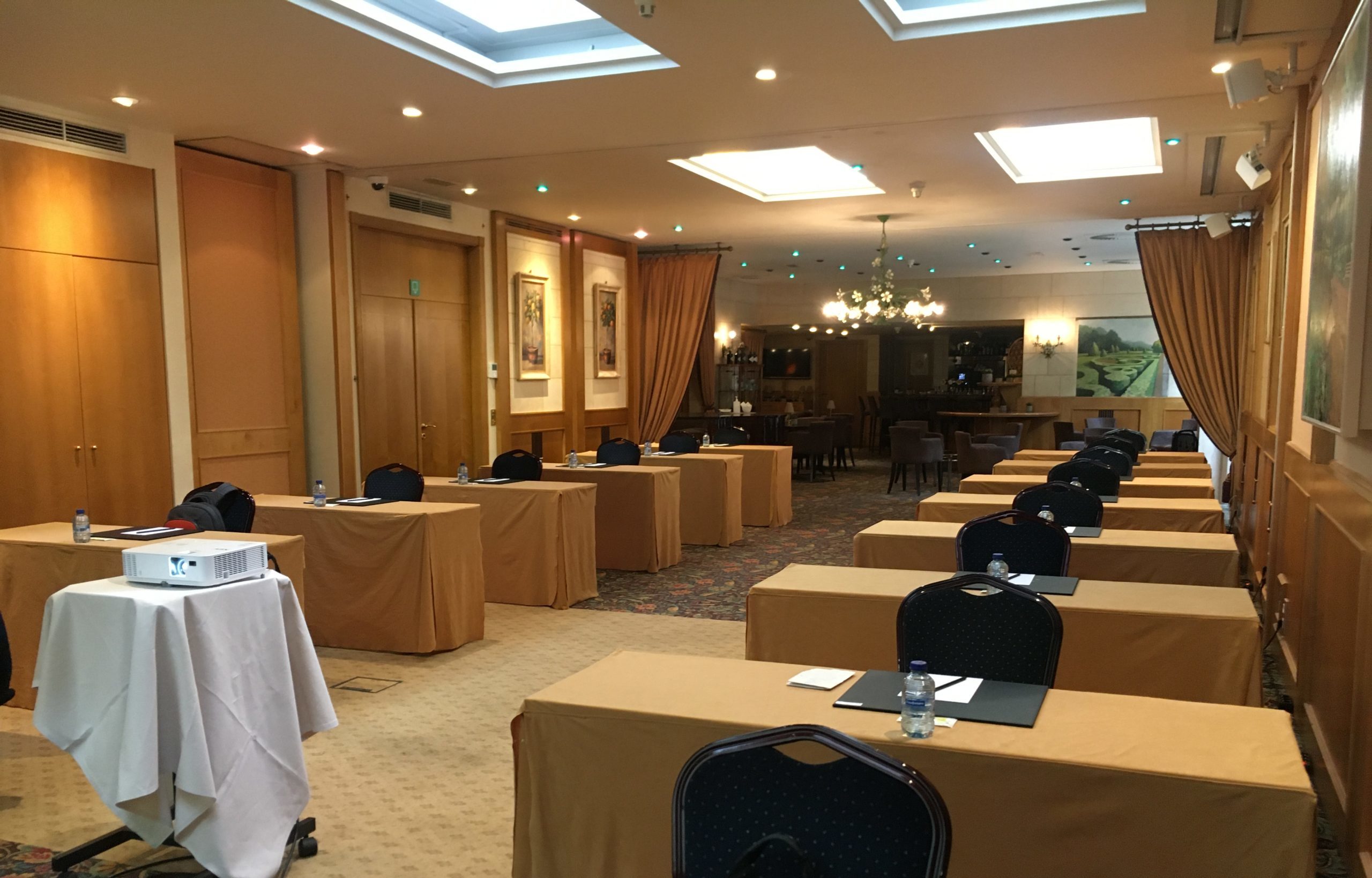
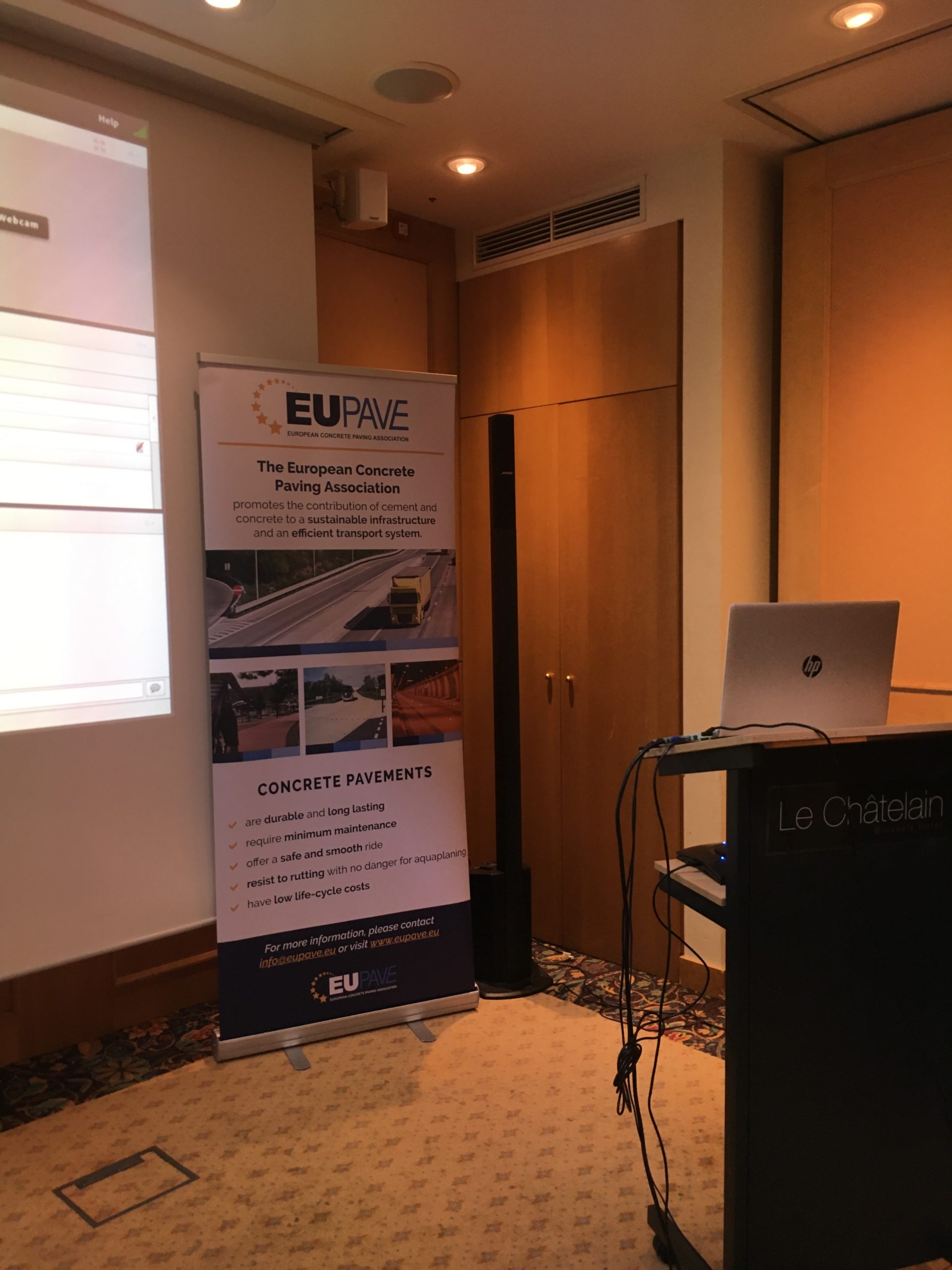
The event has now been rescheduled to Wednesday 14 October from 12.00 to 17.00
Hôtel Le Châtelain, Rue du Châtelain 17, 1040 Brussels
Following the actual sanitary crisis, EUPAVE had to slightly modify the organisation of the workshop. A limited amount of participants will be able to physically attend the event (20), while others will have the possibility to follow the presentations online. Participants will have to stay seated during the event and face coverings will be mandatory. Coffee and biscuits will be served directly to the participant’s table during the coffee break. Cocktail will be replaced by a seated-lunch ahead of the event.
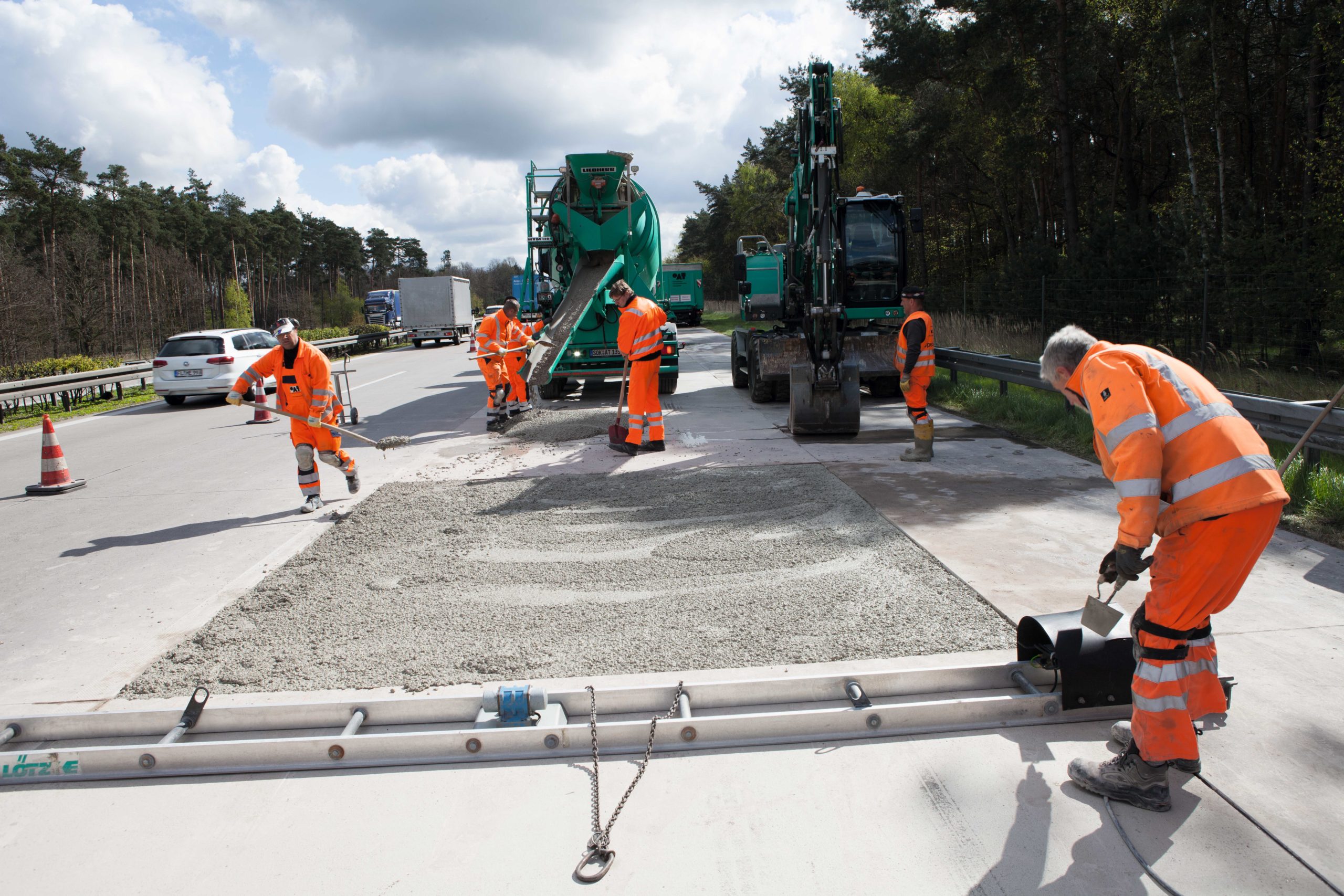
Various topics will be discussed over the day starting with Concrete Pavement Preservation Strategies and Road Condition Assessment, continuing with different Repair Techniques for concrete slabs and CRCP. Finally some innovative developments in concrete preservation will be presented: the use of self-healing concrete and multi-crystalline technologies.
This workshop is intended for experts coming from Road Agencies, Engineering Bureaus, Contractors… who have an interest in the management and preservation of concrete pavements. Participants will have the opportunity to exchange and discuss the specific aspects, challenges and difficulties experienced in that field.
Knowing seats are given in priority to the speakers, there are around 10 seats left.
Register by sending an e-mail to Elise Carabédian, e.carabedian@eupave.eu by Wednesday 7 October 2020. Please specify your participation to the lunch. Thank you
The workshop will also be available online here!
Programme
On Tuesday 18th June, EUPAVE held at the Thon Hotel EU in Brussels its 4th workshop on Best Practices in Concrete Paving. The theme for this year was “Hydraulically Bound Base Layers & Roller Compacted Concrete Pavements”. Attended by around 35 participants, the workshop gathered experts who have an interest in RCC in particular
During this event various topics were discussed over the day starting with hydraulically bound base layers, a general introduction on Roller Compacted Concrete (RCC) and the promotion of RCC across Europe. The situation of RCC in Turkey and the market of RCC in the U.S were also presented.
Each participant received a copy of EUPAVE’s new publication “Roller compacted concrete: making concrete pavements available to the whole pavement building industry”. You can find here the publication.
Mr. Stéphane Nicoud, president of EUPAVE, opened the workshop on behalf of its vice-president, Rory Keogh. He welcomed the attendees and thanked them for their presence.
Mr. Nicoud gave a special welcome to EUPAVE members and partners and introduced EUPAVE’s working groups on Best Practices, Concrete Safety Barriers, Environmental Strategy, EU Advocacy and Communication strategy. He also informed the participants about EUPAVE’s newsletter and different affiliations. He finished his introduction by an overview of the previous workshops on Best Practices organised since 2015.
Mrs. Colette Grégoire, Senior Researcher at the Belgian Road Research Center (BRRC) gave a presentation on the “standards, materials and tests methods” of Hydraulically Bound Base Layers.
Mr. Luc Rens, managing director of EUPAVE, presented the “design, construction and performances” of Hydraulically Bound Base Layers. His presentation focused on the choice of base layer, the different types of HBBL, the construction techniques and ended by final considerations such as the circular economy and climate-resilience.
Mr. Carlos Jofré, consultant, gave a general introduction on Roller Compacted Concrete Pavements. Mr. Jofré explained in which cases using RCC pavements is interesting and where to use them. He went back on the market of RCC pavements and gave some technical information.
Mr. Mathew Tranter from Cemex UK and Mr. José M. Merino, from Cemex Spain highlighted the RCC promotion across Europe.
Following the coffee break, Mr. Ozgur Yaman presented the RCC pavements in Turkey. Mr. Yaman showed the different applications in Turkey and what lessons have been learned regarding the construction of the roads.
Mrs. Anne Beeldens, consultant at AB-Roads, gave a presentation on behalf of Corey Zollinger, Director Paving Solution at Cemex and Chairman of RCC Pavement Council, on the market of RCC pavements in the U.S.
An open discussion followed the presentations.
Finally Stéphane Nicoud drew the main conclusions of the workshop:
- Hydraulically Bound Base Layers are a good solution for all types of pavements
- Several types are available depending on the design parameters,
- The preliminary design study is a good start,
- The resistance to erosion can be more important than just strength
- They fit in the framework of “circular economy” and “climate resilience”.
- RCC pavements are increasingly applied all over the world:
- Equipment are widely available,
- Properties are similar to conventional concrete,
- Mainly for low speed applications,
- Further developments in surface finishing are ongoing,
- A good way to get started with concrete pavements.
The workshop was followed by a cocktail at the hotel restaurant.
- Stéphane Nicoud, president of EUPAVE
- Colette Grégoire, BRRC
- Carlos Jofré, Consultant
- José M. Merino, Cemex
- Ozgur Yaman, TCMA
- EUPAVE new publication on Roller Compacted Concrete Pavement
EUPAVE held its third Workshop on “Best Practices in Concrete Paving” on 23 February 2017 in Brussels. The theme of this edition was “The right concrete mix for the right surface”. Attended by around 50 participants, the workshop gathered concrete paving practitioners such as contractors, designers, engineers, academics, as well as material and equipment manufacturers.
The event also marked the launch of EUPAVE’s new publication “Achieving and Maintaining the Evenness of Concrete Pavements”.
Karl Downey, Secretary General of EUPAVE, opened the workshop on behalf of EUPAVE’s President, Stéphane Nicoud. Following this, Rory Keogh, Chairman of EUPAVE’s Best Practices WG, introduced the agenda of the day and highlighted that best practice sharing is important to ensure excellence not only in design of concrete pavements, but especially in their execution.
Luc Rens, Managing Director of EUPAVE, introduced the speakers and moderated the lively discussion that followed.
Carlos Jofré’s presentation explained the importance of the concrete mixture for evenness and gave practical guidance.
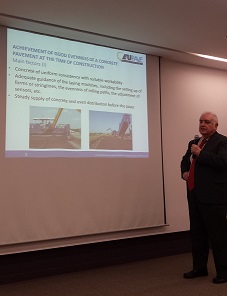
Carlos Jofré presenting “the importance of the concrete mixtture for the evenness of concrete roads”
Jens Skarabis, Silentex, presented the factors that influence skid resistance and explained techniques for achieving the desired skid resistance.
Martin Peyerl, Smart Minerals/VÖZ, presented the experience with two-layered concrete pavements in Austria. He noted that Austria has almost 30 years’ experience in using recycled pavements in the bottom layer of two-layered concrete pavements.
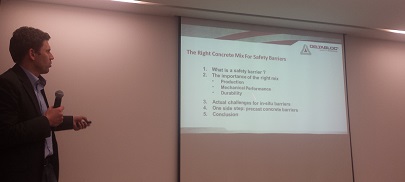
Martin Peyerl presenting the experience with “two-layered concrete pavements” in Austria
In his presentation, Marco Pollok, Deltabloc, spoke about the concrete mix required for successful execution and durability of concrete safety barriers.
Tim Alte-Teigeler, OAT, presented techniques for texturing concrete surfaces, such as micro-milling and diamond grinding.
Finally, Frédéric Ljung, Chryso, demonstrated the wide range of surface effects that can be achieved with decorative concrete, noting that “the only limit is your imagination”.
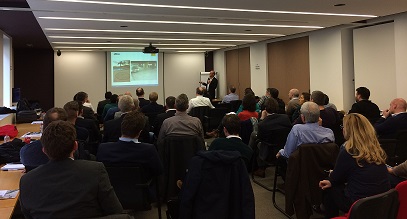
Frédéric Ljung presenting the “Decorative Concrete Surfaces”
In the discussions that followed each presentation, participants shared their own experiences, which in many cases differed per country.
Luc Rens adjourned the workshop by thanking the group for their active participation. The next EUPAVE workshop on innovation is already planned for 23 March 2017: registration here. The topic of the next Best Practices workshop will be determined taking into account the suggestions by the participants.

